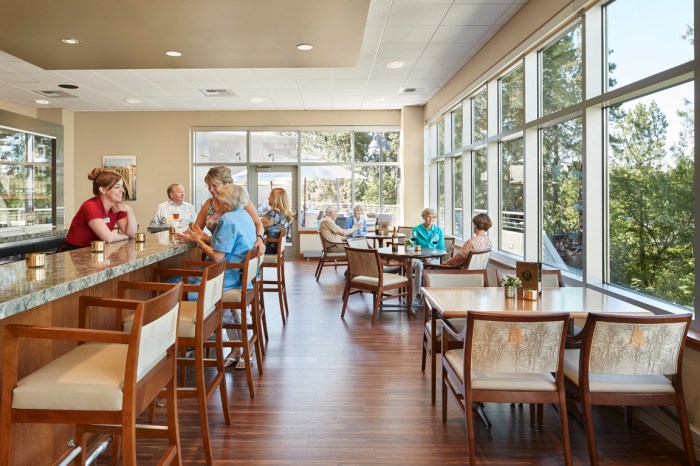Places Old People Go encompasses far more than just physical locations; it’s a journey through diverse living arrangements, healthcare options, and the emotional landscape of aging. This exploration delves into the realities of senior living, from the financial burdens and logistical challenges to the social and emotional well-being of older adults. We examine various facilities, comparing assisted living, nursing homes, independent living communities, and continuing care retirement communities, highlighting their unique features and costs.
Understanding the choices available to seniors and their families is crucial. This guide provides a detailed overview of daily life in these settings, the healthcare services provided, and the critical role of family support. We also address the financial aspects of senior care, exploring funding options and the importance of advance care planning. Finally, we’ll touch upon the often-overlooked aspects of social engagement, accessibility, and the legal rights of older adults.
Financial Aspects: Places Old People Go

The transition to senior living arrangements presents significant financial considerations for individuals and their families. Understanding the various funding options and associated costs is crucial for effective planning and ensuring a comfortable and secure future. This section examines the primary financial pathways for financing senior living, including the roles of government programs and private payment options, alongside a regional cost comparison.
Financing Senior Living Arrangements
Seniors typically finance their living arrangements through a combination of sources. Medicare, the federal health insurance program for those 65 and older, covers some healthcare costs but does not directly pay for housing or long-term care. Medicaid, a joint state and federal program, provides assistance to low-income individuals and families, including some long-term care services, but eligibility requirements are stringent.
Private pay options encompass a wide range, from personal savings and retirement accounts (such as 401(k)s and IRAs) to long-term care insurance policies and reverse mortgages. The financial burden often falls heavily on families, necessitating careful planning and potentially requiring difficult financial decisions. Many seniors deplete their savings to cover the substantial costs of senior living, highlighting the importance of proactive financial planning.
Cost Comparison of Senior Living Options Across Geographic Regions
The cost of senior living varies significantly depending on location, facility type, and the level of care required. The following table provides a generalized comparison of average monthly costs, acknowledging that these figures can fluctuate considerably. These figures represent estimates based on industry averages and may not reflect the actual costs in any given area.
| Location | Facility Type | Average Monthly Cost | Included Services |
|---|---|---|---|
| New York City, NY | Assisted Living | $7,000 – $10,000 | Assistance with daily living, meals, some medication management, social activities |
| Miami, FL | Assisted Living | $5,000 – $7,500 | Assistance with daily living, meals, some medication management, social activities |
| Des Moines, IA | Independent Living | $3,000 – $5,000 | Housing, meals, some amenities, transportation assistance |
| Phoenix, AZ | Skilled Nursing Facility | $8,000 – $12,000 | 24-hour skilled nursing care, medical services, physical therapy, meals |
Financial Planning Considerations for Seniors and Their Families
Effective financial planning is paramount for seniors and their families as they navigate the transition to different living arrangements. This includes a thorough assessment of available resources, such as retirement savings, Social Security benefits, and potential government assistance programs. Detailed cost projections for various living options are crucial to avoid unexpected financial strain. Long-term care insurance, while expensive, can significantly mitigate the financial burden of long-term care, but it’s important to understand the policy terms and coverage carefully.
Estate planning, including wills and power of attorney documents, ensures that financial and healthcare decisions align with the senior’s wishes and protects their assets. Open communication between the senior, their family, and financial advisors is vital for making informed decisions and ensuring a smooth transition. For example, a family might consider downsizing a home to free up capital or explore options like reverse mortgages to access home equity.
Families should also factor in the potential need for ongoing financial support for medical expenses and other care-related costs beyond the basic living arrangements.
Emotional and Social Well-being

Maintaining strong emotional and social well-being is paramount for older adults, significantly impacting their overall health and quality of life. Social isolation and loneliness are increasingly recognized as serious public health concerns, linked to a higher risk of cognitive decline, cardiovascular disease, and even mortality. Addressing these issues requires a multifaceted approach focusing on fostering social connections and community engagement.Social interaction and community engagement are crucial for the emotional well-being of older adults.
Regular social contact provides a sense of belonging, purpose, and reduces feelings of isolation. These interactions stimulate cognitive function, boost mood, and provide emotional support, mitigating the negative impacts of stress and chronic illness. Conversely, a lack of social interaction can lead to depression, anxiety, and a decline in overall health.
Strategies to Combat Loneliness and Isolation
Combating loneliness and isolation among seniors requires tailored strategies depending on their living situation. For those living independently, community-based programs offering social activities, such as senior centers, day programs, and volunteer opportunities, are essential. These settings provide opportunities for interaction, engagement in hobbies, and the development of new friendships. For those in assisted living or nursing homes, structured social activities, regular visits from family and friends, and access to technology facilitating virtual communication are vital.
Technology can play a crucial role in connecting individuals with loved ones and support networks, combating geographic isolation. For example, video calls can help maintain relationships with family who live far away.
The Role of Volunteers and Community Organizations, Places Old People Go
Volunteers and community organizations play a pivotal role in supporting the social and emotional needs of older adults. They provide companionship, assistance with daily tasks, and access to essential services. Organizations such as Meals on Wheels deliver nutritious meals and provide social interaction, while volunteer-driven transportation services ensure access to medical appointments and social activities. These services are not only practical but also crucial for maintaining social connections and reducing feelings of isolation.
For instance, a volunteer visiting a senior regularly can provide not only practical assistance but also valuable companionship and emotional support, reducing feelings of loneliness. The impact of these community efforts extends beyond individual well-being, strengthening the social fabric and fostering a more inclusive society for all ages.
Navigating the complexities of senior care requires a multifaceted approach, encompassing practical considerations, emotional support, and sound financial planning. From understanding the diverse types of facilities and their associated costs to appreciating the crucial role of social interaction and accessibility, this guide aims to equip readers with the knowledge necessary to make informed decisions. Ultimately, ensuring the well-being of older adults involves a collective effort, combining professional care with the dedication of families and supportive communities.
